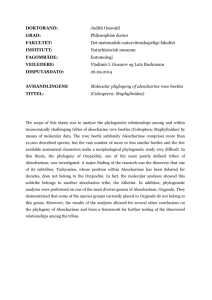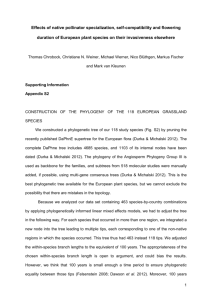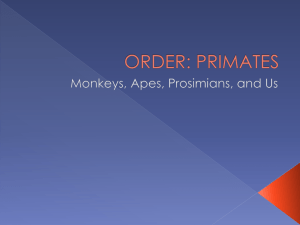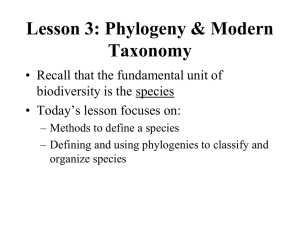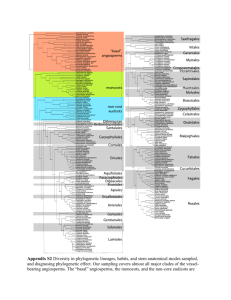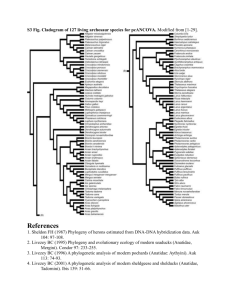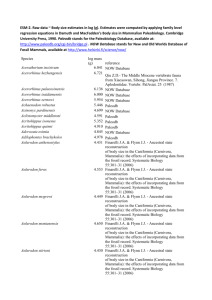README.
advertisement
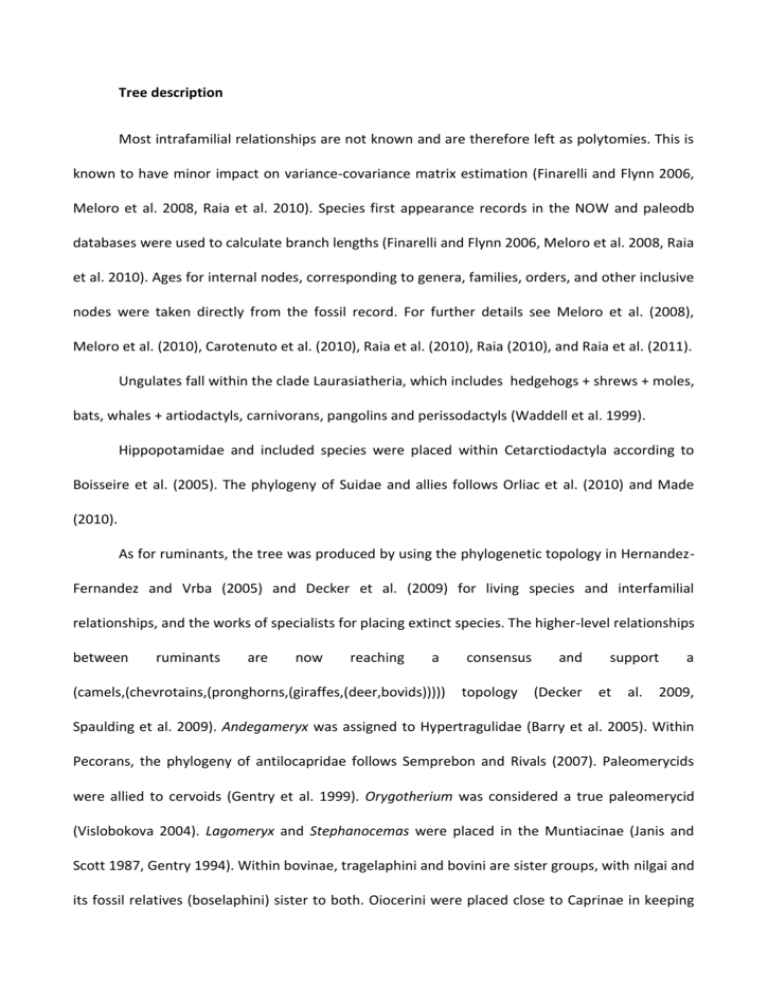
Tree description Most intrafamilial relationships are not known and are therefore left as polytomies. This is known to have minor impact on variance-covariance matrix estimation (Finarelli and Flynn 2006, Meloro et al. 2008, Raia et al. 2010). Species first appearance records in the NOW and paleodb databases were used to calculate branch lengths (Finarelli and Flynn 2006, Meloro et al. 2008, Raia et al. 2010). Ages for internal nodes, corresponding to genera, families, orders, and other inclusive nodes were taken directly from the fossil record. For further details see Meloro et al. (2008), Meloro et al. (2010), Carotenuto et al. (2010), Raia et al. (2010), Raia (2010), and Raia et al. (2011). Ungulates fall within the clade Laurasiatheria, which includes hedgehogs + shrews + moles, bats, whales + artiodactyls, carnivorans, pangolins and perissodactyls (Waddell et al. 1999). Hippopotamidae and included species were placed within Cetarctiodactyla according to Boisseire et al. (2005). The phylogeny of Suidae and allies follows Orliac et al. (2010) and Made (2010). As for ruminants, the tree was produced by using the phylogenetic topology in HernandezFernandez and Vrba (2005) and Decker et al. (2009) for living species and interfamilial relationships, and the works of specialists for placing extinct species. The higher-level relationships between ruminants are now reaching a (camels,(chevrotains,(pronghorns,(giraffes,(deer,bovids))))) consensus topology and (Decker support et al. a 2009, Spaulding et al. 2009). Andegameryx was assigned to Hypertragulidae (Barry et al. 2005). Within Pecorans, the phylogeny of antilocapridae follows Semprebon and Rivals (2007). Paleomerycids were allied to cervoids (Gentry et al. 1999). Orygotherium was considered a true paleomerycid (Vislobokova 2004). Lagomeryx and Stephanocemas were placed in the Muntiacinae (Janis and Scott 1987, Gentry 1994). Within bovinae, tragelaphini and bovini are sister groups, with nilgai and its fossil relatives (boselaphini) sister to both. Oiocerini were placed close to Caprinae in keeping with Solounias (1981). Urmiatherini and Criotherium were allied to ovibovini (Geraads and Spassov 2008). Pliocervini were allied to Cervini (Petronio et al. 2007). The phylogeny of rhinos follows the comprehensive cladistic analysis in Cerdeño (1995), and taxonomic attribution in Lacombat (2003), for some of the species. In keeping with Cerdeño (1995) we placed Diaceratherium in the subfamily Aceratheriinae. Phylogeny and taxonomy of tapiromorph perissodactyls was depicted after Holbrook (1999). The phylogeny and taxonomy of equids follows Strömberg (2006), and Maguire and Stigall (2008). Higher-level tree topology and split ages within Carnivora follows Wesley-Hunt and Flynn (2005) and Finarelli and Flynn [2006, see also Finarelli (2008), Meloro and Raia 2010]. Canid subfamilies ages and relationships were taken from Wang (1994), Wang et al. (1999), Finarelli and Flynn (2006), and Tedford et al. (2010). Internal relationships within Borophaginae canids follow Wang et al. (1999). Within Mustelidae, clades arrangement follows Koepfli et al. (2008). Mephitidae are recognized as a separate family allied to a Procyonidae + Mustelidae clade (Flynn et al. 2005). The phylogeny of the Procyonidae follows Koepfli et al. (2007). Nimravidae are placed basal to other Feliformia, as in Peigné (2003). We depicted internal relationships of this clade according to Peigné (2003) and Morlo et al. (2004) (see Meloro et al. 2008). Pseudaelurus and Proailurus are considered ancestral to all the other feloids. Within the Felidae family, Machairodontinae forma a distinct subfamily. The phylogeny of machairodont felids follows Slater and Van Valkenburgh (2007). The current phylogeny of Felidae is robust but molecular estimates of time of divergence are not (Johnson et al. 2006), and were thence taken directly from the fossil record. Taxonomy and phylogeny of hyenas follow Werdelin and Solounias (1991) and Turner et al. (2007). Viverridae tree topology was taken from Gaubert and Begg (2007), and Gaubert and Cordeiro-Estrela (2006). Hemicyoninae ursids were placed according to Ginsburg and Morales (1998). For internal relationships within Ursidae we followed Mazza and Rustioni (1994), and Amphicyonidae were considered to be the sister clade to other caniformia (WesleyHunt and Flynn 2005b, Finarelli and Flynn, 2006). The tree topology for creodonts follows Polly (1996), Peigné et al. (2007) and Egi et al. (2005, 2007). As for proboscideans, we followed the phylogenetic descriptions and age estimates in Shoshani and Tassy (2005), and Thomas et al. (2000). Literature cited 1. Barry JC, Cote S, MacLatchy L, Lindsay EH, Kityo R, Rajpar AR (2005) Oligocene and Early Miocene ruminants (mammalia, artiodactyla) from Pakistan and Uganda. Palaeont Electr 8, 1-22 2. Boisserie, J. R., Lihoreau, F. and M. Brunet. (2005) The position of Hippopotamidae within Cetartiodactyla. PNAS 102, 1537–1541. 3. Carotenuto F., Barbera C., and Raia P., (2010). Occupancy, range size and phylogeny in Eurasian Pliocene to Recent large mammals. Paleobiology 36, 399-414. 4. Cerdeño, E. (1995) Cladistic analysis of the family Rhinocerotidae (Perissodactyla). Am. Mus. Novit., 1–25. 5. Decker JE et al. (2009) Resolving the evolution of extant and extinct ruminants with high throughput phylogenomics. PNAS 106: 18644–18649. 6. Egi N., Holroyd P. A., Aung Naing Soe, Takai M. and Ciochon R. L. (2005) Proviverrine hyaenodontids (Creodonta: Mammalia) from the Eocene of Myanmar and a phylogenetic analysis of the Proviverrines from the Para-Tethys area. Journal of Systematic Palaeontology 3: 337-358. 7. Egi N., Tsubamoto T. & Takaf M. (2007) Systematic status of Asian “Pterodon” and early evolution of Hyaenaelurine hyaenodontid creodonts. Journal of Paleontology 81: 770-778. 8. Finarelli JA, Flynn JJ (2006) Ancestral state reconstruction of body size in the Caniformia Carnivora, Mammalia: the effects of incorporating data from the fossil record. Syst. Biol. 55:301–313. 9. Finarelli, J. A. (2008). A Total Evidence Phylogeny of the Arctoidea (Carnivora: Mammalia): Relationships Among Basal Taxa. J Mammal Evol 15, 231–259. 10. Flynn JJ, Finarelli JA, Zehr S, Hsu J, Nedbal MA. Molecular phylogeny of the carnivora (mammalia): assessing the impact of increased sampling on resolving enigmatic relationships. Syst. Biol. 2005, 317-337 11. Gaubert P, Begg CM (2007) Re-assessed molecular phylogeny and evolutionary scenario within genets (Carnivora, Viverridae, Genettinae). Mol Phylogenet Evol 44, 920–927 12. Gaubert P, Cordeiro-Estrela P (2006) Phylogenetic systematics and tempo of evolution of the Viverrinae (Mammalia, Carnivora, Viverridae) within feliformians: implications for faunal exchanges between Asia and Africa. Mol Phylogenet Evol 41, 266–278. 13. Gentry AW (1994) The Miocene differentiation of Old World Pecora (Mammalia). Hist Biol 7: 115– 158. 14. Gentry AW, Rössner GE, Heizmann, EPJ (1999): Suborder Ruminantia. – In: Rössner GE, Heissig K (editors): The Miocene Land Mammals of Europe: pp. 225-258. München (Verlag Dr. Friedrich Pfeil). 15. Geraads D, Spassov N (2008) A new species of Criotherium (Bovidae, Mammalia) from the late Miocene of Bulgaria Hellenic J Geosci 43:21-27. 16. Hernandez -Fernandez, M., and Vrba, E.S., (2005) A complete estimate of the phylogenetic relationships in Ruminantia, a dated species-level supertree of the extant ruminants: Biological Reviews, v. 80, p. :269–302. 17. Holbrook, L. T. (1999) The Phylogeny and Classification of Tapiromorph Perissodactyls (Mammalia). Cladistics 15, 331–350. 18. Janis CM, Scott KM (1987) The interrelationships of higher ruminant families with special emphasis on the members of the Cervoidea. Am Mus Novit 2893: 1–85. 19. Johnson WE, Eizirik E, Pecon-Slattery J, Murphy WJ, Antunes A, Teeling E, O’Brien SJ. 2006. The late Miocene radiation of modern Felidae: a genetic assessment. Science 311, 73-77. 20. Koepfli KP, Gompper ME, Eizirik E, Ho CC, Linden L, Maldonado JE, Wayne RK (2007) Phylogeny of the Procyonidae (Mammalia: Carnivora): molecules, morphology and the Great American Interchange. Mol Phylogenet Evol 43, 1076-1095. 21. Koepfli, K.A. Deere, G.J. Slater, C. Begg, K. Begg, L. Grassman, M. Lucherini, G. Veron and R.K. Wayne, (2008) Multigene phylogeny of the Mustelidae: resolving relationships, tempo and biogeographic history of a mammalian adaptive radiation, BMC Biol 6. 22. Made, van der, J. (2010) The pigs and “Old World peccaries”(Suidae and Palaeochoeridae, Suoidea, Artiodactyla) from the Miocene of Sandelzhausen (southern Germany): phylogeny and and an updated classification of the Hyotheriinae and Palaeochoeridae. Paläontologische Zeitschrift, 84, 43–121. 23. Maguire, K. C., and A. L. Stigall. (2008). Paleobiogeography of Miocene Equinae of North America: a phylogenetic biogeographic analysis of the relative roles of climate, vicariance, and dispersal. Palaeogeography, Palaeoclimatology, Palaeoecology 267:175–184 24. Mazza P, Rustioni M. 1994. On the phylogeny of Eurasian bears. Palaeontographica Abt. A 230: 138pp. 25. Meloro C., Raia P. (2010). Cats and dogs down the tree: the tempo and mode of evolution in the lower carnassial of fossil and living Carnivora. Evolutionary Biology 37, 177-186. 26. Meloro, C., P. Raia P, P. Piras P, C. Barbera C, and P. O’Higgins. P (2008. ) The shape of the mandibular corpus in large fissiped carnivores: allometry, function and phylogeny. Zool. J. Linn. Soc. 154:832–845. 27. Morlo M, Peigné S, Nagel D. 2004. A new species of Prosansanosmilus: implications for the systematic relationships of the family Barburofelidae new rank (Carnivora, Mammalia). Zoological Journal of the Linnean Society 140: 43-61 28. Orliac, M. J., P.-O. Antoine, and S. Ducrocq. 2010. Phylogenetic relationships of the Suidae (Mammalia, Cetartiodactyla): new insights on the relationships within Suoidea. Zoologica Scripta 39:315–330. 29. Peigné S. 2003. Systematic review of European Nimravinae (Mammalia, Carnivora, Nimravidae) and the phylogenetic relationships of Palaeogene Nimravidae. Zoologica Scripta 32, 199-229. 30. Peigné S., Morlo M., Chaimanee Y., Ducrocq S., Tun S. T. & Jaeger J.-J. (2007) New discoveries of hyaenodontids (Creodonta, Mammalia) from the Pondaung Formation, middle Eocene, Myanmar – paleobiogeographic implications. Geodiversitas 29, 441-458. 31. Petronio C, Krakhmalnaya T, Bellucci L, Di Stefano G (2007) Remarks on some Eurasian pliocervines: Characteristics, evolution, and relationships with the tribe Cervini. Geobios 40:113–130. 32. Polly, P. D. 1996. The skeleton of Gazinocyon vulpeculus gen. et comb. nov. and the cladistic relationships of Hyaenodontidae (Eutheria, Mammalia). J. Vert. Palaeontol. 16:303–319. 33. Raia P., (2010) Phylogenetic community assembly over time in Eurasian Plio-Pleistocene mammals. Palaios 25, 327–338. 34. Raia P., Carotenuto F., Eronen J.T., Fortelius M. (in press) Longer in the tooth, shorter in the record? The evolutionary correlates of hypsodonty in Neogene ruminants. Proc. Royal Soc Lon B 35. Raia P., Carotenuto F., Meloro C., Piras P., and D. Pushkina (2010). The shape of contention. Adaptation, history and contingency in ungulate mandibles. Evolution 64 (5), 1489 -1503. 36. Semprebon, G. M. and Rivals, F. (2007) Was grass more prevalent in the pronghorn past? An assessment of the dietary adaptations of Miocene to Recent Antilocapridae (Mammalia: Artiodactyla). Palaeogeography, Palaeoclimatology, Palaeoecology 253, 332–347. 37. Shoshani, J., And Tassy, P., (2005), Advances in proboscidean taxonomy and classification, anatomy and physiology, and ecology and behaviour: Quaternary International, v. 126–128, p. 5–20. 38. Slater, G.J., And Van Valkenburgh, B. (2008) Long in the tooth: Evolution of sabertooth cat cranial shape: Paleobiology, v. 34, p. 403–419. 39. Solounias N (1981) The Turolian Fauna from the Island of Samos, Greece, Contributions to Vertebrate evolution 6:l-232. 40. Spaulding M., O’Leary M.A., Gatesy J. (2009). Relationships of Cetacea (Artiodactyla) Among Mammals: Increased Taxon Sampling Alters Interpretations of Key Fossils and Character Evolution. PLoS ONE 4: e7062. 41. Strömberg, C. A. E. (2006). The evolution of hypsodonty in equids: testing a hypothesis of adaptation. Paleobiology 32, 236–258. 42. Tedford RH, Wang X, Taylor BE. 2010. Phylogenetic systematics of the North American fossil Caninae (Carnivora: Canidae). Bullettin of the American Museum of Natural History n. 325. 43. Thomas, M.G., Hagelberg, E., Jones, H.B., Yang, Z., And Lister, A.M., (2000) Molecular and morphological evidence on the phylogeny of the Elephantidae: Proceedings of the Royal Society London B, v. 267, p. 2493–2500. 44. Turner A, Antón M, Werdelin L. (2008) Taxonomy and evolutionary patterns in the fossil Hyaenidae of Europe. Geobios 41, 677–687. 45. Vislobokova I. (2004) New species of Orygotherium (Palaeomerycidae, Ruminantia) from the Early and Late Miocene of Eurasia. Ann Naturhist Mus Wien 106:371–385. 46. Waddell, P. J., Okada, N., and M. Hasegawa. 1999. Towards resolving the interordinal relationships of placental mammals. Systematic Biology 48: 1-5. 47. Wang X. (1994). Phylogenetic systematics of the Hesperocyoninae (Carnivora: Canidae). Bullettin of the American Museum of Natural History n. 221. 48. Wang, X., R. H. Tedford, and B. E. Taylor. 1999. Phylogenetic systematics of the Borophaginae (Carnivora: Canidae). Bulletin of the American Museum of Natural History 243, 1–391. 49. Werdelin, L., Solounias, N., 1991. The Hyaenidae: taxonomy, systematics and evolution. Fossils and Strata 30, 1–104. 50. Wesley-Hunt GD, Flynn JJ. (2005). Phylogeny of the Carnivora: basal relationships among the carnivoramorphans, and assessment of the position of ‘Miacoidea’ relative to Carnivora. Journal of Systematic Palaeontology 3, 1–28. 51. Wesley-Hunt GD, Flynn JJ. (2005b). Phylogeny of the Carnivora: basal relationships among the carnivoramorphans, and assessment of the position of ‘Miacoidea’ relative to Carnivora. Journal of Systematic Palaeontology 3: 1-28.

